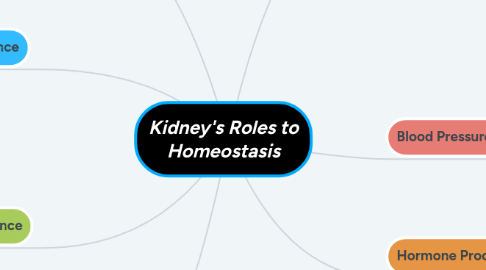
1. Maintains Electrolyte Balance
1.1. Sodium & Chloride
1.1.1. A major solute that influences movement of water and impacts blood volume and blood pressure.
1.2. Potassium
1.2.1. The chief cation is important for maintaining membrane potential of nerves and muscles.
1.3. Calcium
1.3.1. Important for bone density, blood clotting, neurotransmitter release, maintenance of muscle tone, and excitability of nervous and muscle tissue.
1.4. Phosphorus
1.4.1. The chief anion is an important buffer of Hydrogen in body fluids and urine.
1.5. Magnesium
1.5.1. Important for normal neuromuscular activity, synaptic transmission and myocardial functioning.
2. Maintains Fluid Volume Balance
2.1. Antidiuretc Hormone (ADH) or Vasopressin - acts on the kidneys to regulate the volume and osmolality of the urine
3. Maintains Acid-Base Balance
3.1. Bicarbonate Reabsorption
3.1.1. The kidneys restore bicarbonate by releasing hydrogen ions and holding bicarbonate ions.
3.2. Bicarbonate Formation
3.2.1. The buffer, primarily phosphate, becomes acidic, and the extra hydrogen ions are excreted in the urine in the form of phosphoric acid.
3.3. Hydrogen Ion Excretion
3.3.1. The alteration of certain amino acids in the renal tubules results in a diffusion of ammonia into the kidneys where it picks up excess hydrogen ions and is excreted as ammonium. Both phosphoric acid and ammonium are fixed acids. Because fixed acids cannot be destroyed in metabolism or eliminated through the lungs, they must be excreted instead through the kidneys.
4. Vitamin D Synthesis
4.1. Vitamin D is converted in the renal cortex into an active substance. The active form of Vitamin D increases intestinal absorption of calcium and some magnesium and phosphate, increases bone marrow reabsorption of calcium and phosphate, and increases tubular reabsorption of calcium and phosphate in the kidney.
5. Waste Excretion: Urine
5.1. Waste products are products which serve no function to the body. The main nitrogenous waste products which are of concern with respect to the renal function are: Urea and Creatinine
5.1.1. Urea
5.1.1.1. When protein is broken down, the end product is Urea. It is largely derived from nutritional intake and its levels can be influenced based on the amount of protein consumed. Reference levels: 2.5 - 8 mmol/L
5.1.2. Creatinine
5.1.2.1. A better indicator of kidney function is Serum Creatinine because it is a by-product of muscle metabolism. A rise in plasma creatinine is usually indicative of renal dysfunction. Reference levels: less than 133 mmol/L
6. Blood Pressure Regulation
6.1. RAS (Renin-Angiotensin System)
6.1.1. When blood volume or sodium levels in the body are low, or blood potassium is high, cells in the kidney release the enzyme, renin. Renin converts angiotensinogen, which is produced in the liver, to the hormone angiotensin I. An enzyme known as ACE or angiotensin-converting enzyme found in the lungs metabolizes angiotensin I into angiotensin II. Angiotensin II causes blood vessels to constrict and blood pressure to increase. Angiotensin II stimulates the release of the hormone aldosterone in the adrenal glands, which causes the renal tubules to retain sodium and water and excrete potassium. Together, angiotensin II and aldosterone work to raise blood volume, blood pressure and sodium levels in the blood to restore the balance of sodium, potassium, and fluids. If the renin-angiotensin system becomes overactive, consistently high blood pressure results.
7. Hormone Production
7.1. Erythropoietin
7.1.1. - is a glycoprotein that promotes the proliferation and differentiation of erythrocyte precursors in the bone marrow. It is necessary for the maintenance of a normal red cell count and prevention of anemia.
7.2. Aldosterone
7.2.1. - is released by the adrenal cortex with the activation of the renin-angiotensin-aldosterone system that stimulates the collecting ducts to reabsorb more Na+ and Cl- and secrete more K+.
7.3. Calcitriol
7.3.1. - activates Vitamin D, which regulates calcium homeostasis

